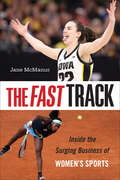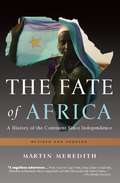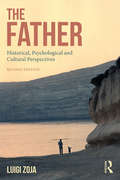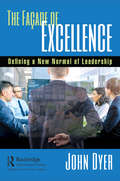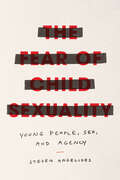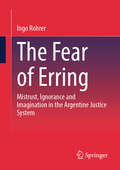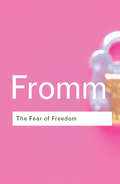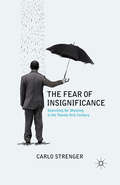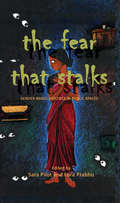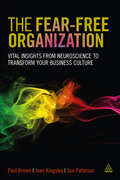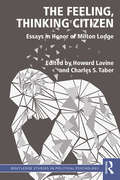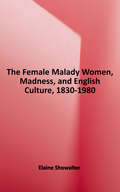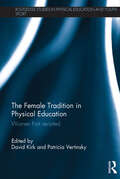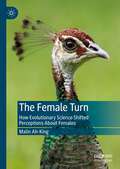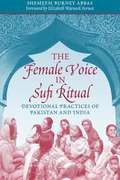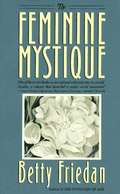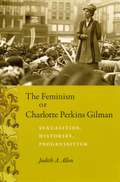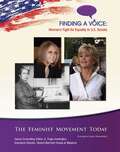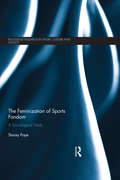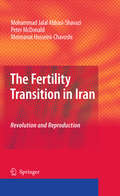- Table View
- List View
The Fast Track: Inside the Surging Business of Women's Sports
by Jane McManus“No one cares about women’s sports” is a familiar refrain from vocal skeptics, but as The Fact Track shows, a series of watershed moments reflect the increasing popularity of and support for women’s sports from both investors and fans. Veteran sports journalist and academic Jane McManus examines both this upward trend and the forces that have held women’s sports back since the early 1970s when Title IX became law (and Billie Jean King soundly defeated Bobby Riggs). As the fervor for Caitlin Clark during the 2024 NCAA Women’s Basketball championship illustrates, there is big money to be made from broadcasting, merchandising, and investing in women’s sports. The Fast Track chronicles how pioneering sponsorships, broadcast opportunities, and surges in ratings contradict the myths about disinterest. Interviews counter the resistance toward women’s leagues, reveal how women are covered in the media, and consider the possibilities for further investment. McManus also addresses racial inclusivity, transgender athletes, women’s health issues, and equal pay. An essential road map to capitalize on untapped potential, The Fast Track provides a snapshot of where women’s sports as an industry and investment stand at this moment in time.
The Fate of Africa: A History of the Continent Since Independence
by Martin MeredithFirst published in 2005, The Fate of Africa was hailed by reviewers as "A masterpiece....The nonfiction book of the year" (The New York Post); "a magnificent achievement" (Weekly Standard); "a joy," (Wall Street Journal) and "one of the decade’s most important works on Africa" (Publishers Weekly, starred review).<P><P> Now Martin Meredith has revised this classic history to incorporate important recent developments, including the Darfur crisis in Sudan, Robert Mugabe’s continued destructive rule in Zimbabwe, controversies over Western aid and exploitation of Africa’s resources, the growing importance and influence of China, and the democratic movement roiling the North African countries of Tunisia, Egypt, and Jordan.
The Father: Historial, Psychological and Cultural Perspectives
by Luigi ZojaCountless children throughout the world grow up without fathers. In this revised and updated edition of The Father, accompanied by a new preface, Luigi Zoja studies the reasons for this and assesses the contribution of this phenomenon to social and psychological problems. Using examples from classical antiquity to the present day, Zoja views the origins and evolution of the father from a Jungian perspective. He argues that the father’s role in bringing up children is a social construction that has been subject to change throughout history, and goes on to examine the consequences and consider the crisis facing fatherhood today. No other existing book faces the subject of fatherhood from such a broad and multidisciplinary perspective. Covering these issues from historical, sociological and psychological points of view, this revised edition of The Father includes a complete reworking of the final part of the book, focusing on the condition of the father in today’s globalized world, and with a particular look at the role historical trauma and grief play in family relationships. The book will be of special interest to analytical psychologists and Jungian psychotherapists in practice and in training, academics and students of Jungian and post-Jungian studies, sociology, anthropology, gender studies, and history.
The Faultline of Consciousness: A View of Interactionism in Sociology
by David MainesIn this compendium of related and cross-referential essays, David R. Maines draws from pragmatist/symbolic interactionist assumptions to formulate a consistent new view of the entire field of sociology. Suitable for courses in social theory, qualitative methods, social psychology, and narrative inquiry, this volume will change the way the general public looks at interpretive sociology.This book is organized as an expression of the centrality of interactionism to general sociology. Each chapter is designed to articulate this view of the field. Symbolic interactionism, the way Maines has come to understand and use it, is essentially the concerted application of pragmatist principles of philosophy to social inquiry.There are four basic elements to this characterization. First, people transform themselves: people are self-aware beings who reflexively form their conduct and thus are capable of adjusting their lines of action and creating new ones. Second, people transform their social worlds: human action takes place in contexts of situations and social worlds. People can modify the social matrices in which they act, and thus people are agents of change. Third, people engage in social dialogue: communication is generic and is at the heart of both stability and change. A fourth element is that people respond to and deal with their transformations. Humans construct situations and societies; they establish social structures and cultures. These are the consequences of human action and, once formed, they reflexively function to direct and channel conduct.Maines argues that when people do things together they can create enduring group formations, such as divisions of labor, rules for inheritance, wage-labor relations, or ideologies. These are instances of group characteristics that influence human conduct and indeed are not reducible to the traits of individuals making up the group or society.
The Façade of Excellence: Defining a New Normal of Leadership
by John DyerThe crucial need to substitute true leadership for bad management practices such as Management By Objectives (MBO) and the use of fear is now well known and was often championed by Dr. W. Edwards Deming. While significant progress has been made, many organizations (especially outside of manufacturing) are either just getting started with their improvement efforts or they are faking their way forward (going through the motions), trying to imitate what they have read in books or have seen at conferences. The executives of these organizations might give permission for the tools of Lean and Six Sigma to be taught but many of them still refuse to look in a mirror and change their own leadership style. They have built a "façade of excellence" that crumbles quickly whenever a bit of chaos is introduced. Not being able to sustain improvements over the long term is one of the top complaints from improvement professionals. What ingredient is missing that prohibits changes to occur throughout the leadership ranks that might create a culture that embraces teamwork, collaboration and improvement? To start, what exactly do we mean by leadership? The common mistake is to try and put all effective leaders into the same box. Leadership actually has many dimensions and several definitions. This book explores four different styles of leadership that includes "The Crisis Leader," "The Idea Gathering Leader," "The Team Forming Leader," and "The Empowerment Leader." Each of the four styles is appropriate when given a certain set of circumstances (an organization in trouble needs a "Crisis Leader" for example). The goal is to shift the organization, including the leaders and all of the employees at every level, toward collaboration and empowerment. Why go through the pains to rebuild an organization’s culture and leaders? In the annual "IndustryWeek Magazine - Best Plants" competition, the companies that have made the transition to high performance, fully empowered teams ("The Empowerment Leader"), in general, demonstrate far better results than all other applicants (and they tend to win "Best Place to Work" awards as well). So, what is keeping organizational leaders, especially those in the middle of the organization chart, from adopting the "The Empowerment" leadership style? This book defines and helps the reader understand what this new normal of leadership consists of and: Explains the four different styles of leaders and how these are different than a typical "old style" manager. Indicates which style is appropriate given a certain set of circumstances and how a leader knows when it is time to migrate from one style to another. Illustrates what it means for an organization to shift from a "dictator" culture to one of collaboration and what steps can be taken to help this transformation. Explores the current definition of a "promotable manager" and how this differs from a new normal definition of an outstanding, effective "Empowerment" leader. Defines Mission, Vision, Strategy, and Values and how these four cultural principles fit into the leadership progression model. Shows how the culture within the organization will be different after the adoption of empowered teams and introduces the concept of "Enthusiastic Productivity."
The Façade of Excellence: Defining a New Normal of Leadership
by John DyerThe crucial need to substitute true leadership for bad management practices such as Management By Objectives (MBO) and the use of fear is now well known and was often championed by Dr. W. Edwards Deming. While significant progress has been made, many organizations (especially outside of manufacturing) are either just getting started with their improvement efforts or they are faking their way forward (going through the motions), trying to imitate what they have read in books or have seen at conferences. The executives of these organizations might give permission for the tools of Lean and Six Sigma to be taught but many of them still refuse to look in a mirror and change their own leadership style. They have built a "façade of excellence" that crumbles quickly whenever a bit of chaos is introduced. Not being able to sustain improvements over the long term is one of the top complaints from improvement professionals. What ingredient is missing that prohibits changes to occur throughout the leadership ranks that might create a culture that embraces teamwork, collaboration and improvement? To start, what exactly do we mean by leadership? The common mistake is to try and put all effective leaders into the same box. Leadership actually has many dimensions and several definitions. This book explores four different styles of leadership that includes "The Crisis Leader," "The Idea Gathering Leader," "The Team Forming Leader," and "The Empowerment Leader."Each of the four styles is appropriate when given a certain set of circumstances (an organization in trouble needs a "Crisis Leader" for example). The goal is to shift the organization, including the leaders and all of the employees at every level, toward collaboration and empowerment. Why go through the pains to rebuild an organization’s culture and leaders? In the annual "IndustryWeek Magazine - Best Plants" competition, the companies that have made the transition to high performance, fully empowered teams ("The Empowerment Leader"), in general, demonstrate far better results than all other applicants (and they tend to win "Best Place to Work" awards as well).So, what is keeping organizational leaders, especially those in the middle of the organization chart, from adopting the "The Empowerment" leadership style? This book defines and helps the reader understand what this new normal of leadership consists of and: Explains the four different styles of leaders and how these are different than a typical "old style" manager. Indicates which style is appropriate given a certain set of circumstances and how a leader knows when it is time to migrate from one style to another. Illustrates what it means for an organization to shift from a "dictator" culture to one of collaboration and what steps can be taken to help this transformation. Explores the current definition of a "promotable manager" and how this differs from a new normal definition of an outstanding, effective "Empowerment" leader. Defines Mission, Vision, Strategy, and Values and how these four cultural principles fit into the leadership progression model. Shows how the culture within the organization will be different after the adoption of empowered teams and introduces the concept of "Enthusiastic Productivity."
The Fear of Child Sexuality: Young People, Sex, and Agency
by Steven AngelidesContinued public outcries over such issues as young models in sexually suggestive ads and intimate relationships between teachers and students speak to one of the most controversial fears of our time: the entanglement of children and sexuality. In this book, Steven Angelides confronts that fear, exploring how emotional vocabularies of anxiety, shame, and even contempt not only dominate discussions of youth sexuality but also allow adults to avoid acknowledging the sexual agency of young people. Introducing case studies and trends from Australia, the United Kingdom, and North America, he challenges assumptions on a variety of topics, including sex education, age-of-consent laws, and sexting. Angelides contends that an unwillingness to recognize children’s sexual agency results not in the protection of young people but in their marginalization.
The Fear of Erring: Mistrust, Ignorance, and Imagination in the Argentine Justice System
by Ingo RohrerThe Fear of Erring, a combination of thick ethnography and an ethnopoetic storyline, illustrates how mistrust, ignorance, and imagination govern the everyday work of personnel in Argentina's criminal justice system. The book shows that Argentina's justice system faces public suspicion and a tense atmosphere of competition and mutual mistrust among employees. It provides evidence of widespread fear among legal professionals of being deceived and making erroneous decisions based on manipulated information. Rational methods of generating knowledge often hit their limits, confronting employees with impenetrable ignorance. The detailed description of bureaucratic life demonstrates that legal professionals resort to imagination and speculation, yielding insights into their moral positioning. By focusing on these imaginaries, the book reveals unnoticed routines and functions of the justice system that shape legal processes, decision-making, and the institution's image. The book's discussion on mistrust, ignorance, and imagination extends beyond Argentina, addressing key questions about social cohesion, knowledge bases, and perspectives on the past and future in current social and global debates.
The Fear of Freedom (Routledge Classics)
by Erich FrommErich Fromm sees right to the heart of our contradictory needs for community and for freedom like no other writer before or since. In Fear of Freedom, Fromm warns that the price of community is indeed high, and it is the individual who pays. Fascism and authoritarianism may seem like receding shadows for some, but are cruel realities for many. Erich Fromm leaves a valuable and original legacy to his readers - a vastly increased understanding of the human character in relation to society. At the beginning of the 21st century, it is more important than ever to be aware of his powerful message. Listen, and take heed.
The Fear of Insignificance: Searching for Meaning in the Twenty-First Century
by C. StrengerThis book shows how, after the fall of the Berlin Wall in 1989, the Gospel of the free market became the only world-religion of universal validity. The belief that all value needs to be quantifiable was extended to human beings, whose value became dependent on their rating on the various ranking-scales in the global infotainment system.
The Fear that Stalks: Gender-based Violence in Public Spaces
by Edited by Sara Pilot Lora PrabhuThis book is an attempt to understand the causes, nature and consequences of gender-based violence in public spaces. It provides a framework that locates gender based violence within the politics and dynamics of public space, and helps us to understand the commonality between these diverse forms of violence, ranging from sexual harassment, sexual assault, moral policing, 'honour' killing, acid throwing, witch hunting, parading naked, tonsuring, rape and homicide. The writers unpack and examine the idea of a 'public' space: although by and large a notional space, they begin by identifying it as the geographical space between the home and the workplace and then, go beyong this to look at the violation faced by homeless women and girls who live on the streets, as well as those who work in public spaces in the unorganised sector.
The Fear-free Organization
by Paul Brown Sue Paterson Joan KingsleyLeadership that makes a difference takes guts and confidence, plus belief in oneself and belief in the key players in the organization. It is built on trust, not fear. Scared people spend a lot more time plotting their survival than working productively, so The Fear- Free Organization has zero tolerance for bullies, vicious gossip, undermining behaviours, hijacking tactics, political jockeying for position or favouritism. Instead, it works on inspiration. Evidence from the new frontiers of neuroscience shows that individuals and organizations are more successful when people are encouraged to take risks, to explore new ideas, and to channel their energies in ways that work for them. The The Fear -Free Organization is a ground-breaking new book that reveals how our new understanding of the neurobiology of the self - how the brain constructs the person - can transform for the better the way our businesses and organizations work.
The Feel of Algorithms
by Minna RuckensteinWhy do we feel excited, afraid, and frustrated by algorithms?The Feel of Algorithms brings relatable first-person accounts of what it means to experience algorithms emotionally alongside interdisciplinary social science research, to reveal how political and economic processes are felt in the everyday. People’s algorithm stories might fail to separate fact and misconception, and circulate wishful, erroneous, or fearful views of digital technologies. Yet rather than treating algorithmic folklore as evidence of ignorance, this novel book explains why personal anecdotes are an important source of algorithmic knowledge. Minna Ruckenstein argues that we get to know algorithms by feeling their actions and telling stories about them. The Feel of Algorithms shows how taking everyday algorithmic emotions seriously balances the current discussion, which has a tendency to draw conclusions based on celebratory or oppositional responses to imagined future effects. An everyday focus zooms into experiences of pleasure, fear, and irritation, highlighting how political aims and ethical tensions play out in visions, practices, and emotional responses. This book shows that feelings aid in recognizing troubling practices, and also calls for alternatives that are currently ignored or suppressed.
The Feeling of the Fall: An Ethnographic Writing Experiment between the Belize Barrier Reef and the Edges of Toronto, Ontario (New Directions in Anthropology #46)
by Ines TacconeAs an inquiry into engagements with forces of loss and threat, this work explores experimental ways to write about climate crisis in anthropology. From Belize to Ontario and back, this ambitious piece of ethnographic writing set during a time “beyond ruin” in a fictional, ecotourist community in the year 2040. Here, loss is taken up through an inventive form of ethnographic storytelling that brings together people, animals, landscapes, and the weather in a world beyond the climate crisis right now where new entanglements with things which have fallen to ruin emerge in imagined milieus in which loss and life converge.
The Feeling, Thinking Citizen: Essays in Honor of Milton Lodge (Routledge Studies in Political Psychology)
by Charles S. Taber Howard LavineThis book is an appreciation of the long and illustrious career of Milton Lodge. Having begun his academic life as a Kremlinologist in the 1960s, Milton Lodge radically shifted gears to become one of the most influential scholars of the past half century working at the intersection of psychology and political science. In borrowing and refashioning concepts from cognitive psychology, social cognition and neuroscience, his work has led to wholesale transformations in the way political scientists understand the mass political mind, as well as the nature and quality of democratic citizenship. In this collection, Lodge’s collaborators and colleagues describe how his work has influenced their own careers, and how his insights have been synthesized into the bloodstream of contemporary political psychology. The volume includes personal reflections from Lodge’s longstanding collaborators as well as original research papers from leading figures in political psychology who have drawn inspiration from the Lodgean oeuvre. Reflecting on his multi-facetted contribution to the study of political psychology, The Feeling, Thinking Citizen illustrates the centrality of Lodge’s work in constructing a psychologically plausible model of the democratic citizen.
The Female Malady: Women, Madness, and English Culture, 1830-1980
by Elaine ShowalterIn this informative, timely and often harrowing study, Elaine Showalter demonstrates how cultural ideas about 'proper' feminine behaviour have shaped the definition and treatment of female insanity for 150 years, and given mental disorder in women specifically sexual connotations. Along with vivid portraits of the men who dominated psychiatry, and descriptions of the therapeutic practices that were used to bring women 'to their senses', she draws on diaries and narratives by inmates, and fiction from Mary Wollstonecraft to Doris Lessing, to supply a cultural perspective usually missing from studies of mental illness.
The Female Tradition in Physical Education: Women First reconsidered (Routledge Studies in Physical Education and Youth Sport)
by David Kirk and Patricia VertinskyThe Female Tradition in Physical Education re-examines a key question in the history of modern education: why did the remarkably successful leaders of female physical education, who pioneered the development of the subject in late nineteenth- and early twentieth-century England, Canada, Australia and New Zealand, lose control in the years following the Second World War? Despite the later resurgence of second wave feminism they never regained a voice, with the result that male leadership was able to shift the curriculum in ways that neglected the needs and interests of girls and young women. Drawing on new sources and a range of historiographical approaches, and touching on related fields such as therapeutic exercise and dance, the book examines the development of physical education for girls in a number of countries to offer an alternative explanation to the dominant narrative of the ‘demise’ of the female tradition. Providing an important contextualization for the state of contemporary female physical education, this is fascinating reading for anybody with an interest in the development of sport and physical education, women’s and gender history, and physical culture more generally.
The Female Turn: How Evolutionary Science Shifted Perceptions About Females
by Malin Ah-KingThis book traces the history of how evolutionary biology transformed its understanding of females from being coy, reserved and sexually passive, to having active sexual strategies and often mating with multiple males. Why did it take so long to discover female active sexual strategies? What prevented some researchers from engaging in sexually active females, and what prompted others to develop this new knowledge? The Female Turn provides a global overview of shifting perceptions about females in sexual selection research on a wide range of animals, from invertebrates to primates. Evolutionary biologist and feminist science scholar Malin Ah-King explores this history from a unique interdisciplinary vantage point. Based on extensive knowledge of the scientific literature on sexual selection and in-depth interviews with leading researchers, pioneers and feminist scientists in the field, her analysis engages with key theoretical approaches in gender studies of science. Analyzing the researchers’ scientific interests, theoretical frameworks, specific study animals, technological innovations, methodologies and sometimes feminist insights, reveals how these have shaped conclusions drawn about sex. Thereby, The Female Turn shows how certain researchers gained knowledge about active females whereas others missed, ignored or delayed it – that is, how ignorance was produced.
The Female Voice in Sufi Ritual: Devotional Practices of Pakistan and India
by Abbas Shemeem BurneyThe female voice plays a more central role in Sufi ritual, especially in the singing of devotional poetry, than in almost any other area of Muslim culture. This research clarifies why the female voice is so important in Sufi practice and underscores the many contributions of women to Sufism and its rituals.
The Feminine Mystique
by Betty FriedanFirst published in 1963, "The Feminine Mystique" ignited a revolution that profoundly changed our culture, our consciousness, and our lives. Today it newly penetrates to the heart of issues determining our lives -- and sounds a call to arms against the very real dangers of a new feminine mystique in the economic and political turbulence of the 1990s. Three decades later, the underlying issues raised by Betty Friedan strike at the core of the problems women still face at home and in the marketplace. As women continue to struggle for equality, to keep their hard-won gains, to find fulfillment in their careers, marriage and family, "The Feminine Mystique" remains the seminal consciousness-raising work of our times.
The Feminism of Charlotte Perkins Gilman: Sexualities, Histories, Progressivism
by Judith A. AllenJudith Allen provides the first comprehensive assessment of Gilman's complicated feminism by exploring the renowned writer's theories of sexuality and evolutionary analyses of androcentric or male-dominated culture.
The Feminist Movement of Today (Finding a Voice: Women's Fight for Equal)
by Elizabeth King HumphreyFor American women, the struggle to win equality has been long and difficult. And the struggle continues. But incredible progress has been made. Much of the credit goes to feminists who refused to accept second-class status because of their gender. This book examines the three historical waves of the American feminist movement. It details the goals and achievements of each wave. It also profiles some of the pioneering women who shattered stereotypes and found success through talent, hard work, and determination.
The Feminization of Sports Fandom: A Sociological Study (Routledge Research in Sport, Culture and Society)
by Stacey PopeWomen fans have entered the traditionally male domain of the sports stadium in growing numbers in recent years. Watching professional sport is important for women for so many reasons, but their expectations and experiences have been largely ignored by academics. This book tackles these shortcomings in the literature and sheds new light on the many ways in which women become sports fans. This groundbreaking study is the first to focus on the phenomenon of the feminization of sports fandom. Including original research on football and rugby union in the UK, it looks at the increasing opportunities for women to become sports fans in contemporary society and critically examines the way this form of leisure is valued by women. Drawing upon feminist thinking and intersectionality, it shows how women from different social classes and age groups consume the spectacle of sport. This book is fascinating reading for any student or scholar interested in sport and leisure studies, sociology and gender or women’s studies.
The Feral Classroom (Routledge Revivals)
by James MacphersonFirst published in 1983, The Feral Classroom argues that the experience of schooling needs to be understood in terms of peer interaction in the classroom. Students’ interaction mediates the significance of the curriculum and teacher, and is, in its own right, a major agent of socialisation.The study reported in the book was conducted in an Australian state high school. It employs ethnographic techniques focused on students’ accounts of relations and activities with classmates. Concepts embodied in these accounts are interpreted through models of school and peer group as agents of socialisation.The volume fills several gaps. It is the first book to describe at length students’ accounts of classroom interaction; to give equal weight to boys’ and girls’ accounts; and to describe dominant students’ determination of the use of classroom norms and of the definition of performances. This book will appeal to a wide range of readers including, but not limited to, teachers, educational administrators, and sociologists.
The Fertility Transition in Iran
by Meimanat Hosseini-Chavoshi Mohammad Jalal Abbasi-Shavazi Peter McdonaldConfounding all conventional wisdom, the fertility rate in the Islamic Republic of Iran fell from around 7.0 births per woman in the early 1980s to 1.9 births per woman in 2006. That this, the largest and fastest fall in fertility ever recorded, should have occurred in one of the world's few Islamic Republics demands explanation. This book, based upon a decade of research is the first to attempt such an explanation. The book documents the progress of the fertility decline and displays its association with social and economic characteristics. It addresses an explanation of the phenomenal fall of fertility in this Islamic context by considering the relevance of standard theories of fertility transition. The book is rich in data as well as the application of different demographic methods to interpret the data. All the available national demographic data are used in addition to two major surveys conducted by the authors. Demographic description is preceded by a socio-political history of Iran in recent decades, providing a context for the demographic changes. The authors conclude with their views on the importance of specific socio-economic and political changes to the demographic transition. Their concluding arguments suggest continued low fertility in Iran. The book is recommended to not only demographers, social scientists, and gender specialists, but also to policy makers and those who are interested in social and demographic changes in Iran and other Islamic countries in the Middle East. It is also a useful reference for demography students and researchers who are interested in applying fertility theories in designing surveys and analysing data.
